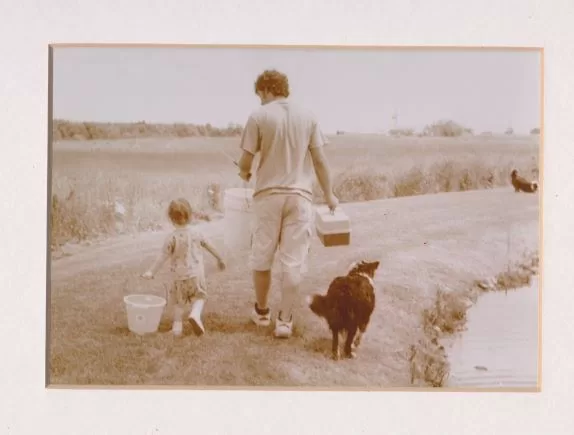Her addictions ruled her. It affected all of her decision making. When she had what she wanted she collapsed into neurotic pleasure and forgot about those who cared for her. When she didn’t have it she was consumed with achieving the buzz. As for the rest of us, we had little chance at intervening. When she put her head against the window, stared at the tire and drooled onto the dusty floor, we knew there was nothing we could do for her.
Emily, our border collie, loved to ride. She followed us all day in hopes that we were heading towards a vehicle. Sometimes she laid in the shade of tractor steps for hours, waiting. Once inside, she was untenable. She bunched herself in the corner, leaned on her front paws, and snapped at the wheel below her whenever the sounds of the tractor changed pitch. In the back of the pickup she spun around in circles and barked wildly in the air, no matter how many times my father leaned out the window and yelled at her.
It may be only human to not always notice the things we see around us every day. I had this experience in our kitchen. I got in from the morning milking, left my dirty jeans crumpled on the floor, and sat down at the table with a cup of coffee. As I stared vacantly, nothing particular on my mind, I noticed ears of corn hanging from the ceiling. Thinking back, I reasoned that they must have been there as decoration for at least a couple of years. Then I saw above the telephone the silhouette of a cow made out of bent wire. It had a basket attached to it. Next to it was a cow wind chime. There were other things: a “Got Milk” poster with the Dixie Chicks, a Bonnie Mohr picture, a true-type model of a Holstein, a photograph of a cow that classified excellent, a “Have You Hugged a Farmer Today?” sticker on the refrigerator, a toy tractor on the counter. I don’t see our family as overly campy people. Still, I could not imagine a librarian having so many pictures of books, or a lawyer with memorabilia of courthouses. One would have thought with all the time spent with cattle in the barn we would have gotten our fill of them by the time we made it to the house. Were we obsessed with this thing called farming?
They say that pets and their owners have a tendency to look like each other. Perhaps the argument can be made that ourselves and Emily acted alike in fixation—her in trying to get a lift from any point to another, and us preoccupied with the farming lifestyle. Maybe it’s natural to embrace the identity of something that requires so much of yourself. Either way, I resolved to judge neither dog nor person on the homestead too severely, because both seemed equally lost to their causes.
Emily aged, but her persistence never waned. Sometimes we saw her walking up the hill to my grandparents, because she knew they would inevitably drive her back home. If we called to her she would only tuck her head and run away faster. Even when her joints grew sore she still put her front paws on the steps of the John Deere and insist to be hoisted in.
One day she was found dead in the tractor. She rode in the John Deere as it filled up the mixer wagon in the morning and had remained there, as she often did, to wait for it to be used later in the day. It seemed like the proper end to her story. Still, I’m not sure what it means to us: if we’re to take it as a warning or an example.
How do you memorialize a farm dog? We joke that in the absence of an ocean nearby the best any of us can hope for when we pass is to be put in the back of the manure spreader and applied to the field. This might have been the sendoff to lesser pets at various times, but Emily rests under a crabapple tree in the lawn. It seems to me that the body retains a physical memory of the things it is use to doing. That is why one can fork hay, wash the parlor, and go about daily chores with a wandering mind. In the same way I am convinced that my hands still remember the feel of her coat and the shape of her body, unforgettable after a childhood of leaning over the steering wheel to rub her ears and placate her madness.
*
This article is part of The Milk House column series, published in print across three countries and two languages. It can also be found at themilkhouse.org.
This article appeared in a similar form in Progressive Dairyman in 2012.

